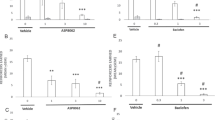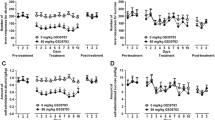Abstract
Rationale
A growing number of studies suggest that γ-aminobutyric acid type-B (GABAB) receptor agonists reduce alcohol use and craving.
Objectives
This study was designed to further clarify behavioral mechanism(s) by which GABAB agonists may decrease alcohol reinforcement.
Methods
Male C57BL/6 J mice were trained to lever press on a concurrent schedule of ethanol (10% v/v) and water reinforcement during 16-h overnight sessions. Effects of the GABAB agonist baclofen (0–17 mg/kg, IP) or SKF 97541 (0–1 mg/kg, IP) were examined on parameters of self-administration. Subsequently, potential motor inhibition and interaction with ethanol-induced sedation by GABAB agonists was examined in ethanol naive and self-administering mice.
Results
Baclofen (10 mg/kg) and SKF 97541 (0.3 mg/kg) reduced ethanol-reinforced responding. In a locomotor activity test, these doses of the GABAB agonists inhibited locomotion in the ethanol-experienced mice and in a group of ethanol-inexperienced mice; locomotor suppression was greater in the ethanol-inexperienced mice. These doses of the GABAB agonists also potentiated the sedative effects of ethanol (4 g/kg) and converted a nonsedative dose of ethanol (2 g/kg) into a fully sedative dose. GABAB agonist enhancement of the sedative effects of ethanol was less pronounced in ethanol self-administering mice, suggesting cross-tolerance at the low dose of ethanol.
Conclusions
GABAB agonists decrease the reinforcing effects of ethanol at doses that inhibit locomotor activity and potentiate the sedative hypnotic effects of ethanol. These nonspecific effects of GABAB agonists were reduced in alcohol experienced mice, suggesting cross-tolerance to the inhibitory properties of GABAB positive modulation. These data question the safety of prescribing GABAB agonists to alcoholics since these drugs may potentiate ethanol’s sedative/hypnotic effects during relapse.




Similar content being viewed by others
References
Addolorato G, Caputo F, Capristo E, Colombo G, Gessa GL, Gasbarrini G (2000) Ability of baclofen in reducing alcohol craving and intake. II. Preliminary clinical evidence. Alcohol Clin Exp Res 24:67–71
Addolorato G, Caputo F, Capristo E, Domenicali M, Bernardi M, Janiri L, Agabio R, Colombo G, Gessa GL, Gasbarrini G (2002) Baclofen efficacy in reducing alcohol craving and intake: a preliminary double-blind randomized controlled study. Alcohol Alcohol 37:504–508
Agmo A, Giordano M (1985) The locomotor-reducing effects of GABAergic drugs do not depend on the GABAA receptor. Psychopharmacology 87:51–54
Ågmo A, Soria P (1997) GABAergic drugs and sexual motivation, receptivity and exploratory behaviors in the female rat. Psychopharmacology 129:372–381
Allan AM, Harris RA (1989) A new alcohol antagonist: phaclofen. Life Sci 45:1771–1779
Allan AM, Burnett D, Harris RA (1991) Ethanol-induced changes in chloride flux are mediated by both GABA(A) and GABA(B) receptors. Alcohol Clin Exp Res 15:233–237
Anstrom KK, Cromwell HC, Markowski T, Woodward DJ (2003) Effect of baclofen on alcohol and sucrose self-administration in rats. Alcohol Clin Exp Res 27:900–908
Broadbent J, Harless WE (1999) Differential effects of GABA(A) and GABA(B) agonists on sensitization to the locomotor stimulant effects of ethanol in DBA/2J mice. Psychopharmacology 141:197–205
Chester JA, Cunningham CL (1999) Baclofen alters ethanol-stimulated activity but not conditioned place preference or taste aversion in mice. Pharmacol Biochem Behav 63:325–331
Colombo G, Agabio R, Carai MA, Lobina C, Pani M, Reali R, Addolorato G, Gessa GL (2000) Ability of baclofen in reducing alcohol intake and withdrawal severity. I. Preclinical evidence. Alcohol Clin Exp Res 24:58–66
Colombo G, Serra S, Brunetti G, Atzori G, Pani M, Vacca G, Addolorato G, Froestl W, Carai MA, Gessa GL (2002) The GABA(B) receptor agonists baclofen and CGP 44532 prevent acquisition of alcohol drinking behaviour in alcohol-preferring rats. Alcohol Alcohol 37:499–503
Colombo G, Serra S, Brunetti G, Vacca G, Carai MA, Gessa GL (2003a) Suppression by baclofen of alcohol deprivation effect in Sardinian alcohol-preferring (sP) rats. Drug Alcohol Depend 70:105–108
Colombo G, Vacca G, Serra S, Brunetti G, Carai MA, Gessa GL (2003b) Baclofen suppresses motivation to consume alcohol in rats. Psychopharmacology 167:221–224
Cott J, Carlsson A, Engel J, Lindqvist M (1976) Suppression of ethanol-induced locomotor stimulation by GABA-like drugs. Naunyn Schmiedebergs Arch Pharmacol 295:203–209
Cousins MS, Roberts DC, de Wit H (2002) GABA(B) receptor agonists for the treatment of drug addiction: a review of recent findings. Drug Alcohol Depend 65:209–220
Daoust M, Saligaut C, Lhuintre JP, Moore N, Flipo JL, Boismare F (1987) GABA transmission, but not benzodiazepine receptor stimulation, modulates ethanol intake by rats. Alcohol 4:469–472
De Luca C, Massotti M (1990) Phaclofen antagonizes the antinociceptive but not the sedative effects of (−)-baclofen. Prog Neuropsychopharmacol Biol Psychiatry 14:597–607
Faigle JW, Keberle H (1972) The chemistry of lioresal. Postgrad Med J Suppl 5:9–13
Frye GD, Taylor L, Trzeciakowski JP, Griffith WH (1991) Effects of acute and chronic ethanol treatment on pre- and postsynaptic responses to baclofen in rat hippocampus. Brain Res 560:84–91
Gianutsos GMK (1978) Tolerance to the effects of baclofen and gamma-butyrolactone on locomotor activity and dopaminergic neurons in the mouse. J Pharmacol Exp Ther 207:859–869
Grech DM, Balster RL (1993) Pentobarbital-like discriminative stimulus effects of direct GABA agonists in rats. Psychopharmacology 110:295–301
Hodge CW, Chappelle AM, Samson HH (1995) GABAergic transmission in the nucleus accumbens is involved in the termination of ethanol self-administration in rats. Alcohol Clin Exp Res 19:1486–1493
Levy RA, Proudfit HK (1977) The analgesic action of baclofen [beta-(4-chlorophenyl)-gamma-aminobutyric acid]. J Pharmacol Exp Ther 202:437–445
Lewis JL, Westerberg VS, LaBella FS (1989) Mechanisms of general anaesthesia: brain regional responses to baclofen. Physiol Behav 46:3–8
Mandema JW, Heijligers-Feijen CD, Tukker E, De Boer AG, Danhof M (1992) Modeling of the effect site equilibration kinetics and pharmacodynamics of racemic baclofen and its enantiomers using quantitative EEG effect measures. J Pharmacol Exp Ther 261:88–95
Martz A, Deitrich RA, Harris RA (1983) Behavioral evidence for the involvement of gamma-aminobutyric acid in the actions of ethanol. Eur J Pharmacol 89:53–62
McBride WJ, Le AD, Noronha A (2002) Central nervous system mechanisms in alcohol relapse. Alcohol Clin Exp Res 26:280–286
Mead AJ, Little HJ (1995) Do GABAB receptors have a role in causing behavioural hyperexcitability, both during ethanol withdrawal and in naive mice? Psychopharmacology 117:232–239
Mehta AK, Ticku MK (1990) Are GABAB receptors involved in the pharmacological effects of ethanol? Eur J Pharmacol 182:473–480
Middaugh LD, Frackelton WF, Boggan WO, Onofrio A, Shepherd CL (1992) Gender differences in the effects of ethanol on C57BL/6 mice. Alcohol 9:257–260
Munzar P, Kutkat SW, Miller CR, Goldberg SR (2000) Failure of baclofen to modulate discriminative-stimulus effects of cocaine or methamphetamine in rats. Eur J Pharmacol 408:169–174
Petry NM (1997) Benzodiazepine-GABA modulation of concurrent ethanol and sucrose reinforcement in the rat. Exp Clin Psychopharmacol 5:183–194
Rodgers RJ, Depaulis A (1982) GABAergic influences on defensive fighting in rats. Pharmacol Biochem Behav 17:451–456
Samson HH (1986) Initiation of ethanol reinforcement using a sucrose-substitution procedure in food- and water-sated rats. Alcohol Clin Exp Res 10:436–442
Samson HH (1987) Initiation of ethanol-maintained behavior: a comparison of animal models and their implication to human drinking. In: Thompson T, Dews PB, Barrett JE (eds) Adv Behav Pharmacol, vol 6. Neurobehavioral Pharmacology. Lawrence Erlbaum, Hillsdale, NJ, pp 221–248
Shellenberger MK, Groves L, Shah J, Novack GD (1999) A controlled pharmacokinetic evaluation of tizanidine and baclofen at steady state. Drug Metab Dispos 27:201–204
Shelton KL, Balster RL (1994) Ethanol drug discrimination in rats: substitution with GABA agonists and NMDA antagonists. Behav Pharmacol 5:441–451
Smith BR, Robidoux J, Amit Z (1992) GABAergic involvement in the acquisition of voluntary ethanol intake in laboratory rats. Alcohol Alcohol 27:227–231
Smith BR, Boyle AE, Amit Z (1999) The effects of the GABA(B) agonist baclofen on the temporal and structural characteristics of ethanol intake. Alcohol 17:231–240
VanDierendonk DR, Dire DJ (1999) Baclofen and ethanol ingestion: a case report. J Emerg Med 17:989–993
Zaleski MJ, Nunes Filho JR, Lemos T, Morato GS (2001) GABA(B) receptors play a role in the development of tolerance to ethanol in mice. Psychopharmacology 153:415–424
Zarrindast MR, Hosseini-Nia T, Allah-Maddadi S (1989) Food intake suppressant effect of baclofen in rats. Gen Pharmacol 20:701–703
Acknowledgements
This work was supported by grants AA09981 and AA011605 to C.W.H. from the National Institute on Alcohol Abuse and Alcoholism and by the Bowles Center for Alcohol Studies.
Author information
Authors and Affiliations
Corresponding author
Rights and permissions
About this article
Cite this article
Besheer, J., Lepoutre, V. & Hodge, C.W. GABAB receptor agonists reduce operant ethanol self-administration and enhance ethanol sedation in C57BL/6J mice. Psychopharmacology 174, 358–366 (2004). https://doi.org/10.1007/s00213-003-1769-3
Received:
Accepted:
Published:
Issue Date:
DOI: https://doi.org/10.1007/s00213-003-1769-3




